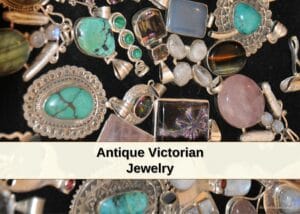If you’re a fan of antique jewelry, then Victorian is easily one of the most exciting styles to collect. Authentic pieces from Queen Victoria’s era tell stories of love, mourning, and many other emotional themes and show incredible artistry!
That is what makes Victorian jewelry a strong attraction for modern collectors, especially women. But the problem is, not many know how to tell the difference between a reproduced piece worth $10 and a genuine Victorian piece worth $1,000 or more!
In this guide, I am going to tell you all about spotting authentic Victorian pieces, understanding what makes them valuable, and some rare examples of their real-time values. Don’t sell or buy your jewelry before reading this!
How to Spot Real Antique Victorian Jewelry? (4 Key Signs)
Even though antique Victorian jewelry bears a distinctive, dramatic look, it is at times a tad difficult to identify the authentic pieces from similar designs or modern replicas.
That is why it is good to know the essential features of original Victorian jewelry, something that undoubtedly distinguishes the 19th-century style!
1. Design Elements
Victorian jewelry represents an era itself, but it also underwent some style shifts during the whole period from the late 1830s to the 1900s. Understanding these changes in designs and subjects can be of great help in authenticating and dating Victorian pieces.
Early Victorian Jewelry (1837-1860)
Early Victorian Jewelry revolves around romantic themes, so you’ll see hearts everywhere: hands holding hearts, arrows through hearts, love knots that can’t be untied. Similarly, Serpent jewelry, a symbol of eternal love, became popular after Prince Albert gave Victoria a serpent engagement ring.
You’ll also find lots of flowers. Roses, forget-me-nots, ivy, you name it. Bows and ribbons were quite common, and so were birds, vines, leaves, anchors, crosses, and human features, like hands and eyes.
Mid-Victorian Jewelry (1861-1885):
This period mourned a great loss with Queen Victoria after Prince Albert died in 1861, and saw the rise of “mourning jewelry.” Dominating black tones, like jet, onyx, and black enamel, and motifs like Urns, weeping willows, and crosses will distinguish this jewelry.
Hair jewelry also became popular during this time. You would see pieces featuring deceased people’s hair in intricate patterns inside lockets.
The Victorians also got inspired by archaeology, and new digs in Greece, Rome, and Egypt led to “revival” styles. Etruscan granulation work (tiny gold beads) became a new hit. Overall, Mid-Victorian jewelry was dramatic and ornate!
Late Victorian Jewelry (1885-1901):
Jewelry from this era shifted toward lighter and more delicate designs. You will generally find feminine designs, but lighter and more graceful than the Grand Period. These flowing designs later became Art Nouveau.
You’ll also see a lot of Japanese and Egyptian influences, like “Shakudo” metalwork (mixing silver, gold, and copper) and “piqué” work (inlaying gold into tortoiseshell).
Some common motifs from the Aesthetic Period are stars, crescents, and horseshoes. Some pieces may also show romantic revival elements, like floral garlands and bows.
2. Jewelry Materials (Metal & Stones)
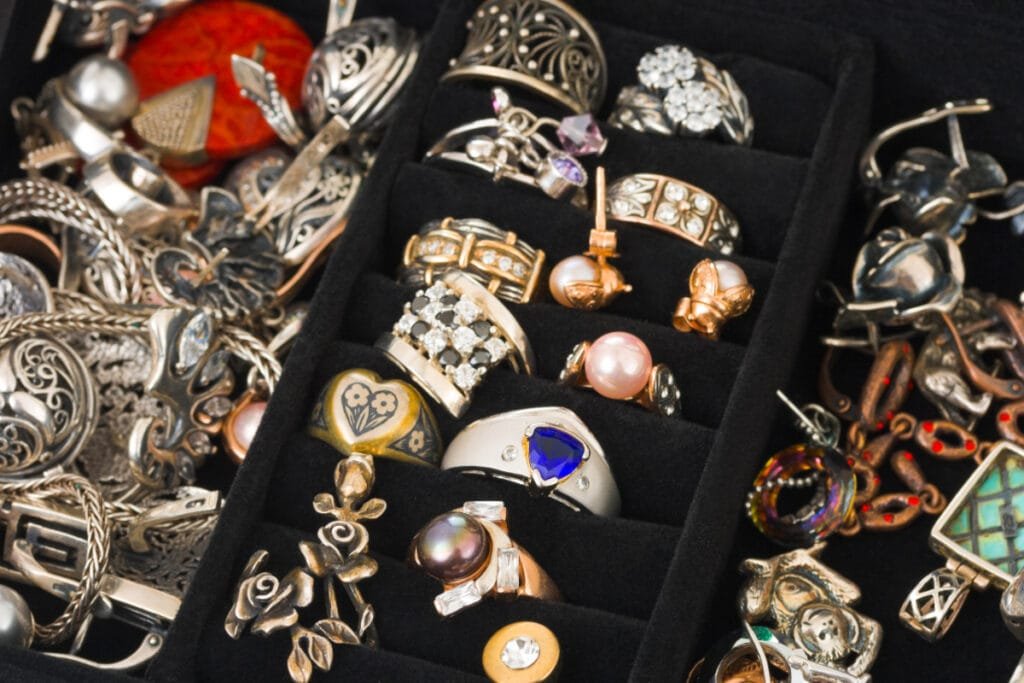
Authentic Victorian jewelry can have a vast array of materials because the Victorians had access to materials from all over the globe. But a few were more favored than others, including:
Common Metals:
- 18k to 22k Gold: This was the go-to standard for early Victorian pieces before 1854, as only these high purities were legally allowed in Britain.
- 9k, 12k, and 15k Gold: After 1854, these purities became legal, making jewelry more affordable for the rising middle class.
- Colored Gold (Rose and Green): Different alloys created warm pinkish and subtle greenish tones, perfect for floral designs.
- Silver: Gaining traction during the mid-Victorian era, silver became more accessible and affordable after the Nevada silver discoveries in the 1860s.
- Rolled Gold: This involves thin sheets of gold soldered onto base metal, offering more durability than plating at a lower cost.
- Pinchbeck: An alloy of copper and zinc (83% copper, 17% zinc) which so closely resembled gold that it came to be called “poor man’s gold.”
Popular Gemstones & Others:
- Diamonds: Once rare and pricey, diamonds became more available after the South African mines opened in 1867.
- Garnets: Particularly the deep red Bohemian garnets, known for their rich, wine-dark color, were a favorite for their dramatic flair in Victorian jewelry.
- Turquoise: This stone was commonly used to symbolize forget-me-nots and remembrance in Victorian pieces.
- Seed pearls: Tiny freshwater pearls that made “pearl” jewelry accessible to everyone.
- Coral: Deep red Mediterranean coral, a symbol of beauty and protection, was frequently found in early Victorian designs.
- Jet and onyx: These materials are iconic in mourning jewelry.
- Amethyst, emerald, and Quartz: Semi-precious stones that were widely used throughout the Victorian era for more affordable jewelry options.
Apart from these, exotic materials like ivory and tortoiseshell were also popular for decorative elements in Victorian jewelry.
3. Craftsmanship and Construction
Most of the authentic Victorian jewelry is all hand-made. So, you will find different craftsmanship, techniques, and construction signs on these pieces than in modern jewelry.
Decoration Techniques:
You will see unique handmade techniques in genuine antique Victorian jewelry. One of the most popular is Repoussé. It involves hammering designs from the back to create raised patterns on the front.
Then there is Granulation, found in most Victorian pieces, which uses tiny gold balls to create textured surfaces. Filigree or lace-like patterns from fine wire, hand engraving, and Milgrain detailing were other common techniques from this era.
Setting Techniques:
Most earliest Victorian pieces show closed-back settings with foiled backings, but later pieces show the “claw” settings (metal crimped around the stone). A collet setting with a metal rim wrapped around the stone’s edge is another common feature seen in many examples.
Gypsy and Pavé settings also became popular for small stone work.
Construction Details:
Victorian pieces have quite different clasps than modern jewelry. For example, brooches typically have C-clasps, simply curved ones. Then there are Trombone hinges that look like tiny telescopes (patented 1850). Pins usually extend past the brooch body.
Safety catches weren’t invented until around 1890. If you see a modern safety catch on “Victorian” jewelry, it’s either been altered or it’s a reproduction.
Look for hand-finished edges and visible solder joints. Modern casting creates perfect uniformity that handwork never achieves.
Stone Cuts:
Stones were also cut quite differently back in the Victorian era, giving you a clear sign of age and authenticity. Some of the most common cuts found in antique Victorian jewelry are:
- Rose Cut: A stone with a flat bottom and domed top covered in triangular facets is rose cut. Every other Victorian piece shows this.
- Old Mine Cut: Most popular of all, the old mine cut gives a square-ish shape with a large culet.
- Cabochon Cut: This creates a domed surface and was commonly used for garnets and colored stones.
- Carbuncles: Specifically, cabochon-cut garnets, usually deep red varieties popular in pendants and brooches.
4. Hallmarks and Marks
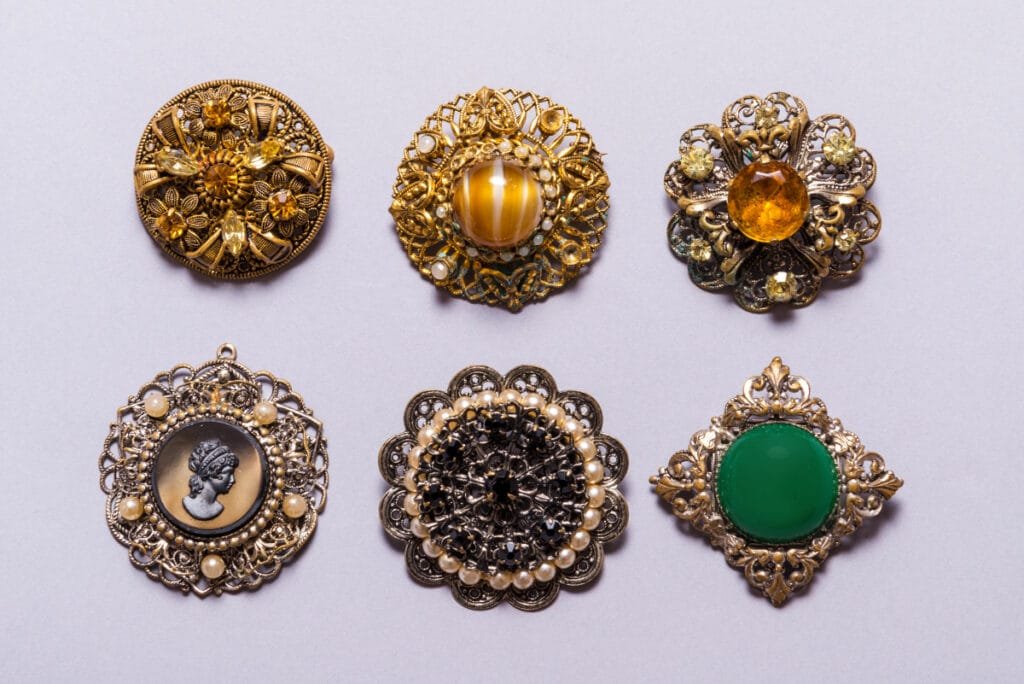
Understanding markings is your key to dating and authenticating Victorian jewelry. The marking systems were completely different between Britain and America, which makes understanding them even more important to spot authentic pieces.
Hallmarks:
These markings are crucial to finding out the metal of a Victorian piece and its purity. Since Victorian jewelry was being made everywhere, you may find two types of Hallmarks:
– British Hallmarks:
British hallmarking was incredibly detailed and regulated. Each assay office had its own mark. For example, London used a leopard’s head, Birmingham an anchor, and Chester three wheatsheaves.
Then there are purity marks to know the metal content. “18k” or “22k” for gold before 1854, then “9k,” “12k,” and “15k” became legal for lower-grade pieces. Sterling silver is marked “925” for its purity level.
Also, British pieces usually show date letters that changed every year. So if you can read them, you know exactly when a piece was hallmarked.
– American Hallmarks:
American Victorian jewelry is trickier because most pieces have no marks at all. The government didn’t require hallmarking like Britain did. When you do find marks, they’re usually just quality indicators like “14k” or “10k” on later pieces.
Makers’ Marks
Maker’s marks are unique stamps that can help you identify who made the piece. It’s a must for attribution and value. Many British pieces clearly show the brand or maker’s name or logo stamped or engraved on jewelry.
For American pieces, maker’s marks didn’t become mandatory until 1961, long after the Victorian period ended. So, most American jewelry won’t have any maker’s mark, either.
Remember, real hallmarks are stamped into the metal, creating clean, sharp impressions. If you see any fuzzy marks that lack the crisp edges of genuine stamps, it may point to a reproduction or a fake.
The proportion should also look right for the piece size. Tiny marks on large pieces or huge marks on delicate jewelry are red flags. Most importantly, the marks should match what was actually used during the Victorian period.
Easy Tips to Spot Reproduction Pieces
With growing popularity, many small makers try to sell modern jewelry designed as “Victorian” by replicating the designs and materials. And although modern fakes are getting advanced, there will still be signs of reproductions.
- Visible casting seams. Modern pieces are often cast, not hand-made, leaving visible seams.
- Check for over-perfection and uniformity that handmade pieces never show. Modern solder looks different from period work.
- You’ll find faux or artificial materials, like synthetic stones that didn’t exist in Victorian times. Also, perfectly laser-cut stones with utmost precision are a sign of modern make.
- Mismatched designs. Reproductions often mix design elements from different periods incorrectly, like modern clasps on “Victorian” pieces or motifs that weren’t popular or known back then.
- Artificial aging is usually obvious. Real patina develops slowly and unevenly. Fake aging looks forced and, well, fake!
4 Factors That Determine Victorian Jewelry’s Value!
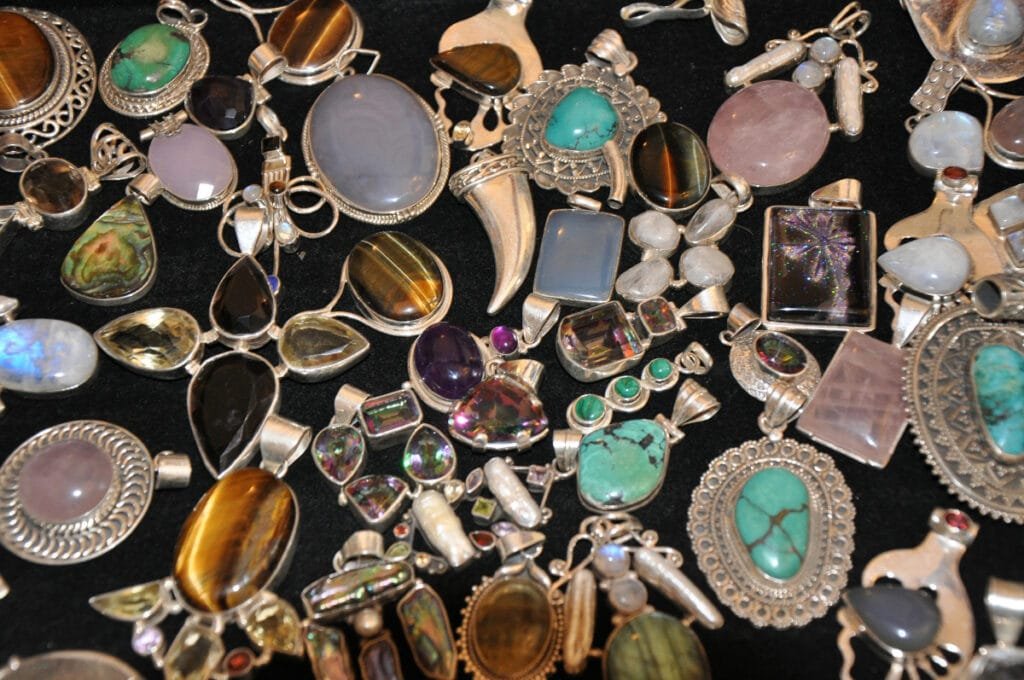
So, now you know how to identify a genuine Victorian piece. But if you believe all of those things are going to be thousands of dollars worth, well, that’s not the complete picture.
Victorian jewelry does come in a broad array of materials and styles, but some other things also contribute significantly to whether or not something is going to be worth a few dollars or a considerable sum!
1. Condition & Completeness
Condition is a huge value factor for antique Victorian jewelry, as finding a piece in excellent condition from that era is really a big deal. Secondly, nobody would want to pay hefty money for damaged jewelry.
So, look for the following signs to assess your piece’s value:
- Completeness: Pieces with Intact settings and secure stones are worth more.
- Functionality: Having functional clasps can enhance the value.
- Original Components: Unmodified pieces sell for more than those that have been restored or patched up (particularly do-it-yourself patches).
- Surface Condition: Minimum wear, original patina, and clear engravings will increase the monetary value, whereas corrosion, dents, and deep scratches will reduce it.
- Stone Condition: Check for chips and cracks on stones or lost stones. These signs can severely reduce the overall worth.
In addition, collectors prefer complete jewelry sets over single pieces. So, matched sets (parures) are generally worth much more than a single necklace. (But the value depends on other factors, as well.)
2. Materials
In the case of antique jewelry, the more precious the metal and gemstones, the more valuable the piece. This means that high-karat gold pieces with natural gemstones are typically worth the most.
Early Victorian work with real pearls is also extremely valuable, as the majority of “pearls” nowadays are cultured. Also, unusual colored stones from particular localities (Kashmir sapphires, Burmese rubies) might drive the price higher.
The size and quality of the stones also matter a lot in determining the value. A perfect small stone trumps a big, imperfect one.
3. Rarity
Rarity is what makes the $500 piece different from the $5,000 piece in Victorian jewelry. The less available the piece or design, the more valuable and coveted it is. Look out for these characteristics to determine if your Victorian brooch or necklace is rare or not:
- Discontinued Materials: If the Victorian piece is made of discontinued materials, such as rare Bog oak and gutta-percha, or incorporates rare enamel techniques, it’s rare.
- Unusual Designs: Pieces with distinctive design elements or motifs that were not widely used in that era are the most valuable.
- Brand Reputation: Victorian pieces by recognized masters or renowned jewelry firms such as Castellani, Giuliano, or Brogden are highly rare and attract premiums.
- Regional Variations: Regional variations, like Scottish agate jewelry or Irish Celtic patterns, are highly prized among collectors and are highly valued.
- Early Innovation: Pieces with advanced techniques (reversible or multipurpose designs), rare for their time, may boost Victorian craftsmanship value.
4. Provenance & Documentation
Provenance and historical importance can bring enormous worth to common Victorian items. A piece with some connection to Queen Victoria herself, or jewelry that was worn on special occasions, is museum material.
Ownership by famous people is worth something as well; items owned by or associated with well-known Victorians such as Charles Dickens or Florence Nightingale may be worth a great deal of money.
Because you will require proofs of provenance, historical documentation comes into play here. Search for original receipts issued by Victorian jewelers, letters from family members referencing individual pieces, or period photos of the person wearing the jewelry. This documentation could double the value of the jewelry.
11 Examples of Rare Victorian Jewelry (Worth Thousands!)
1. Emerald Diamond Garnet Seed Pearl Snake Pin
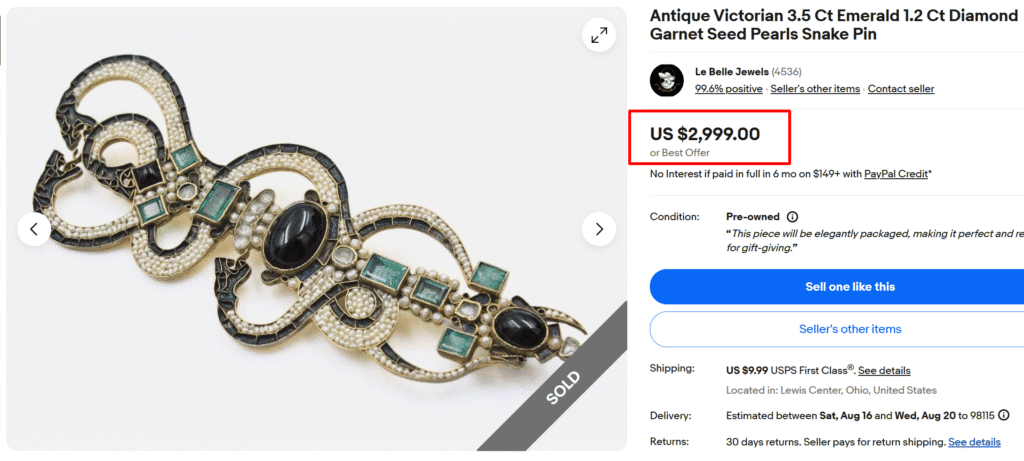
- Brand: Unmarked
- Material: Copper & Zinc
- Stones: Emerald, Diamond, Garnet, Seed Pearls
A magnificent serpent pin from the time when Victorian jewelry was the most elaborate and symbolic. This marvelous piece carries 3.5 carats of emeralds, 1.2 carats of diamonds, garnets, and seed pearls, all the expensive stones in one piece; no wonder it sold for $3,000!
Snake jewelry became a must-have for women after Prince Albert gave Queen Victoria a snake engagement ring, making serpent motifs a distinctive feature of the early Victorian jewelry.
2. Memento Mori Victorian Ring
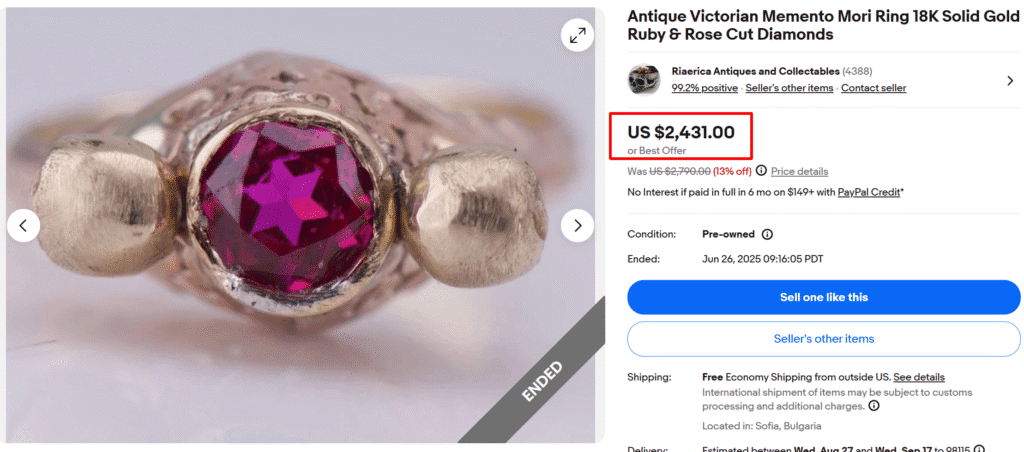
- Brand: Unmarked
- Material: 18K Gold
- Stones: Ruby & Diamond
Victorian jeweler loves the themes of mortality and remembrance, and this piece shows that! It’s a Memento mori ring, meaning “remember you must die.” This jewelry was popular as both a mourning piece and a philosophical reminder.
Also, these rings often featured skulls, crossbones, or other mortality symbols, just like this piece. You’ll see a vibrant ruby in the center, and rose-cut diamonds set as eyes of the skull on both ends. These historical Victorian pieces are worth thousands today!
3. Egyptian Revival Blue Carved Scarab Ring
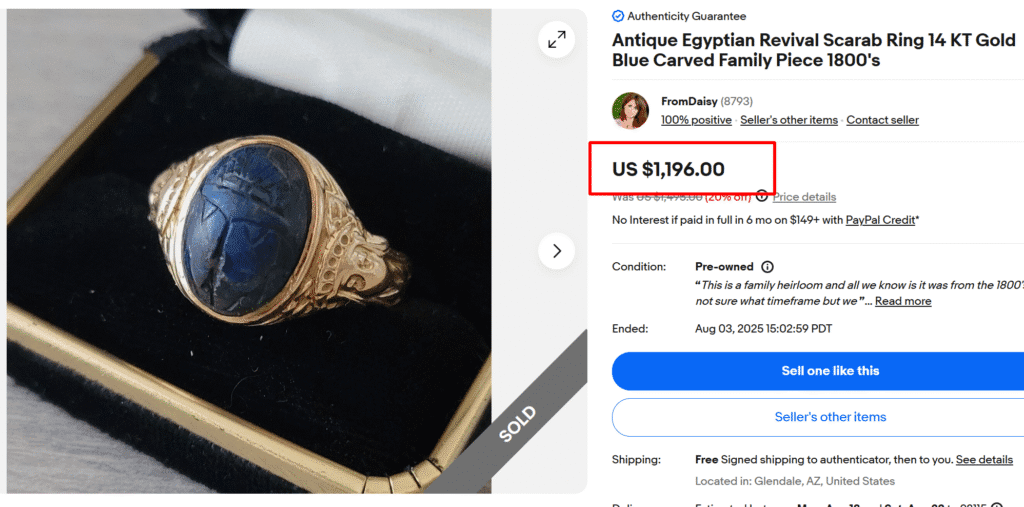
- Brand: Unmarked
- Material: 14K Gold
- Stones: Scarab
This family heirloom from the 1800s shows how Victorian jewelry designs were deeply inspired by ancient Egypt. The gold ring features a well-carved blue scarab held with intricate shoulders echoing Egyptian lotus motifs.
Egyptian Revival jewelry peaked during the Victorian era with archaeological discoveries. Finding these pieces in excellent condition, that too with rich provenance and documentation, is really a great deal today!
4. Imperial Faberge Serpent Gold Brooch
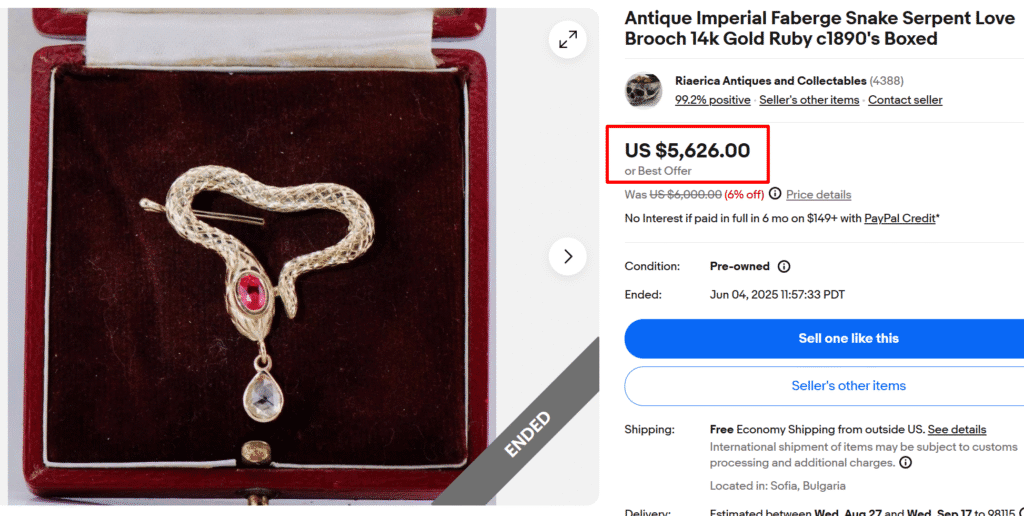
- Brand: Imperial Faberge
- Material: 14K Yellow Gold
- Stones: Ruby
Dating to the 1890s, this stunning 14k gold brooch bears the coveted Imperial Russian hallmarks and Fabergé’s signature. The serpent motif was one of the most notable elements during the early Romantic Victorian era, placing this piece somewhere between 1837-1860.
You can see intricate scale detailing and a cabochon ruby accent, with a dangling tear-shaped old rose cut diamond.
The combination of stones like ruby and diamond, and Fabergé’s craftsmanship with the original box, justifies the steep price tag of $5K!
5. Hand-Carved Hard Stone Cameo Pendant
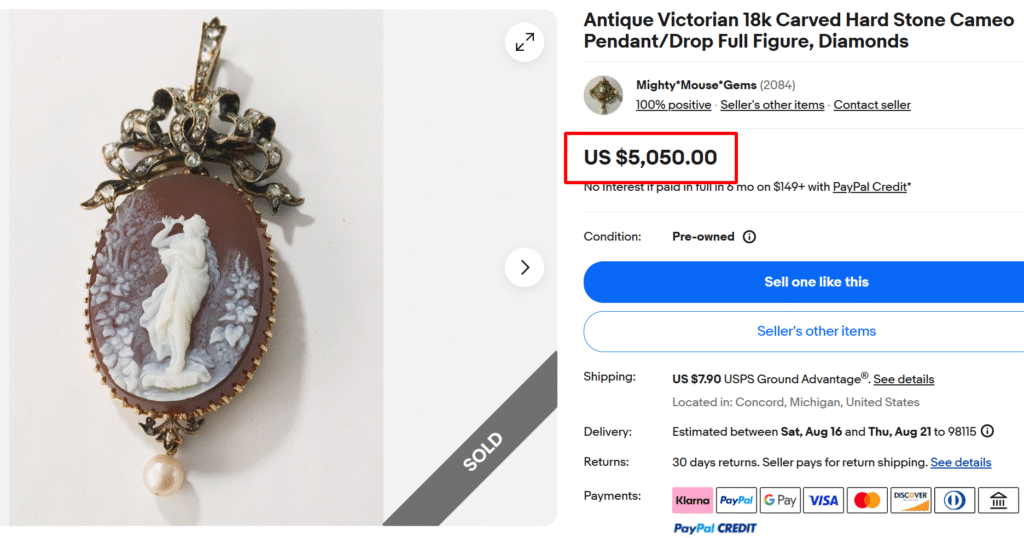
- Brand: Unmarked
- Material: 18K Gold
- Stones: Hard Stone
This is a museum-quality piece! It’s a Victorian pendant showing a full-figure cameo carved from hard stone, likely sardonyx or agate. You can see that elaborate diamond-set mounting with rose-cut stones and a dangling pearl at the bottom, authenticating the Victorian make!
Weighing almost 22 grams, this piece is a perfect example of high-end Victorian cameo jewelry!
6. Salmon Carved Coral Figurial Earrings
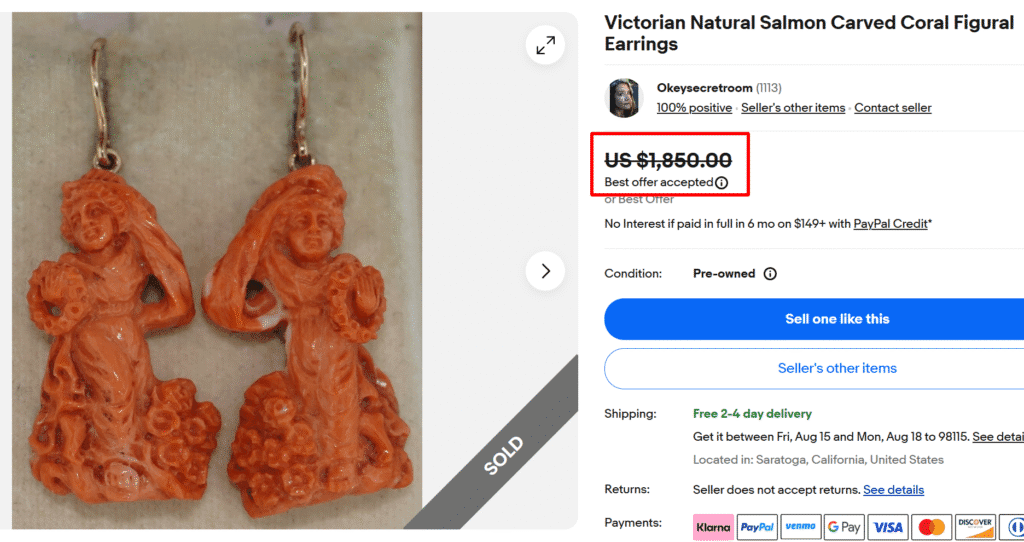
- Brand: Unmarked
- Material: Metal
- Stones: Coral
Heavily carved figurative pieces and cameos are one of the defining features of Victorian jewelry, just like these earrings. Each piece shows the warm, peachy coral hand-carved into detailed figural designs related to classical subjects and floral motifs popular during the era.
Coral was believed to protect against evil and ward off illness, and was a favorite christening gift for Victorian children. Victorian coral jewelry is highly desirable for the natural Mediterranean coral’s rich color and exceptional carving!
7. 1890s Silver Scottish Agate Snake Brooch
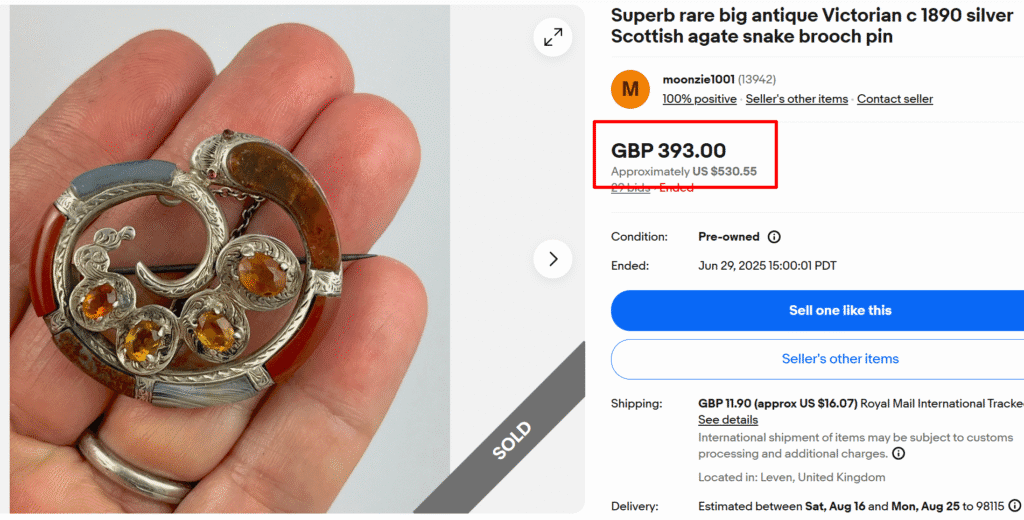
- Brand: Unmarked
- Material: Silver
- Stones: Scottish Agate
Scottish agate jewelry holds a strong connection with Queen Victoria, who fell in love with Highland culture during her stays at Balmoral Castle, making it valuable. This serpentine brooch pin is a Scottish “pebble jewelry” piece made from sterling silver and featuring multiple colors of native Scottish agates!
8. Late Victorian Opal & Diamond Bracelet
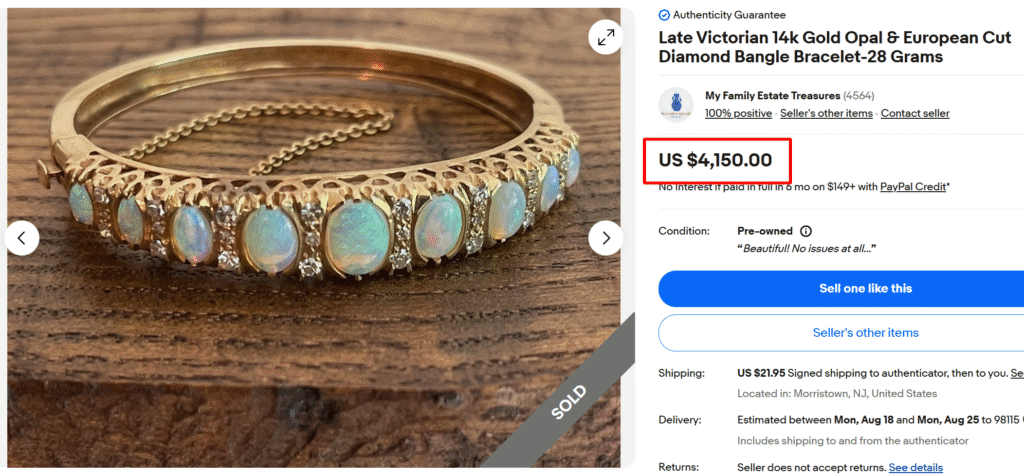
- Brand: Unmarked
- Material: 14K Gold
- Stones: Opal & Diamonds
A beautiful piece from the late Victorian era, this gold bracelet with lustrous opals and European-cut diamonds is a rare find; it sold for over $4,000!
Opals were quite cherished during the late Victorian period for their mysterious color-changing properties. Combined with European-cut diamonds and a 14K solid gold setting, this piece becomes a collector’s dream.
9. Gold Filled Sapphiret Heart Pendant
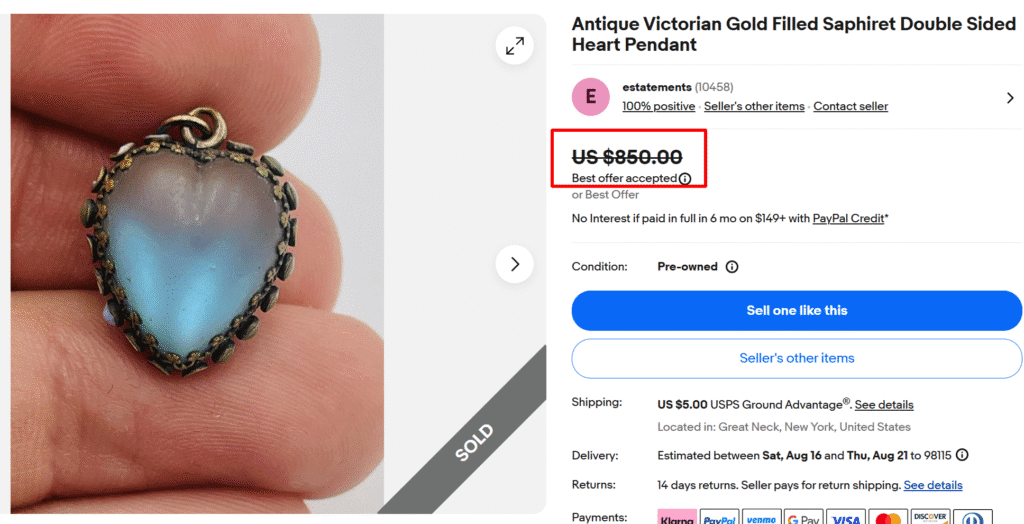
- Brand: Unmarked
- Material: Gold-filled
- Stones: Sapphiret
This is an example of affordable Victorian jewelry! The adorable Victorian pendant features “sapphiret,” a Victorian-era synthetic sapphire used for making affordable pieces. It’s a double-sided design that lets you wear the heart either way, showing its beautiful color transition.
You’ll see the gold-filled construction that looks like solid gold, but isn’t. The heart was one of the most notable design elements of Victoria’s romantic jewelry and is greatly collectible today.
10. Victorian Gold Garnet Necklace
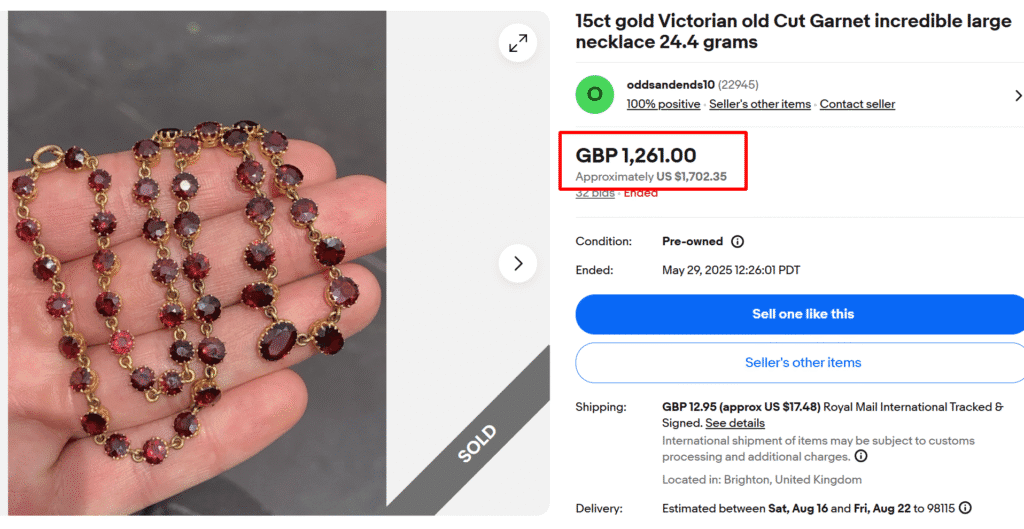
- Brand: Unmarked
- Material: Yellow Gold
- Stones: Old Cut Garnets
This stunning rivière necklace proves how popular garnets were in the Victorian era. Weighing 24.4 grams, this necklace features graduated old-cut garnets that increase in size toward the center.
The 15ct gold setting was the standard for fine Victorian jewelry, and these old-cut garnets display the hand-cut technique unlike modern pieces. Victorian Rivière necklaces with such precious stones could easily sell for thousands, depending on the condition.
11. Antique Pietra Dura 14K Gold Onyx Pendant
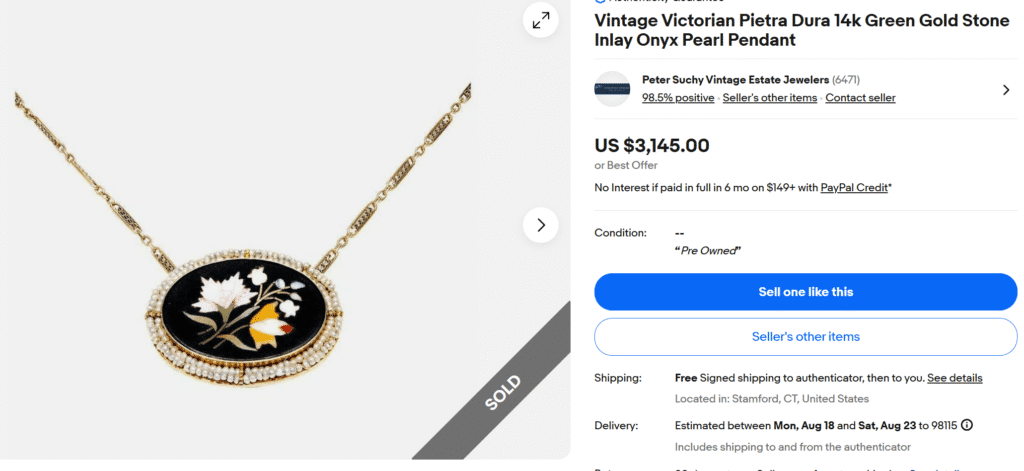
- Brand: Unmarked
- Material: 14K Green Gold
- Stones: Onyx Pearl
This exquisite Victorian pendant features the iconic Italian art of Pietra Dura, which involves creating “paintings in stone” by precisely cutting and fitting colored gemstones together.
It holds a large black onyx showing an intricate floral pattern inlaid with coral and other colorful stones. The onyx is surrounded by over 140 tiny natural seed pearls in a double border, all set in a 14k green gold setting!
This late 1800s piece is a true example of the combination of Victorian style with Italian craftsmanship, making it desirable!
Note: This article is intended for informational, educational, and entertainment purposes only. Some images are illustrative and may not represent actual brands, products, or related entities. All trademarks, product names, brand logos, packaging, and other intellectual property referenced remain the exclusive property of their respective owners. Any brand mentions or references are provided solely for descriptive and educational context and do not imply any formal or commercial association.

